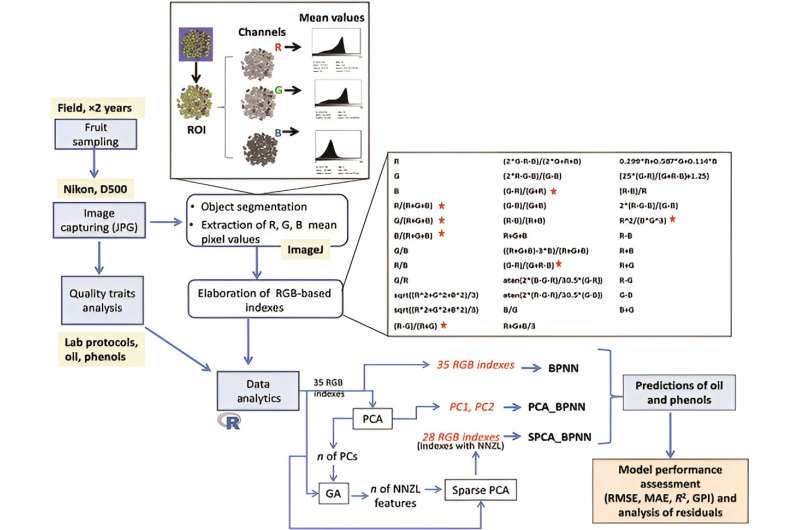This article has been reviewed according to Science X's editorial process and policies. Editors have highlighted the following attributes while ensuring the content's credibility:
fact-checked
trusted source
proofread
RGB imaging and neural networks unveil seasonal oil and phenol variations for olive crop quality assessment

Olive oil, renowned for its antioxidants like phenolic compounds, plays a pivotal role in the global olive crop. The concentration of oil and phenols in olives, varying seasonally, significantly affects crop profitability and quality, dictating the optimal harvest time.
Current research is directed towards leveraging plant phenomics and RGB imaging techniques to non-invasively monitor quality traits, particularly focusing on chlorophyll concentration, a key indicator correlated with oil quality. However, the integration of RGB indexes to effectively track olive quality traits, especially within a regression framework, remains an area with untapped potential.
Artificial neural networks (ANNs) are increasingly used for predicting plant traits, but challenges like overfitting necessitate combining ANNs with principal component analysis and genetic algorithms for enhanced reliability and interpretability.
In June 2023, Plant Phenomics published a research article titled "Phenotyping key fruit quality traits in olive using RGB images and back propagation neural networks."
In this study, researchers aimed to test the hypothesis that predicting oil and phenol concentrations in olives throughout the season is achievable using a Back Propagation Neural Network (BPNN) fed with RGB-based colorimetric indexes derived from imaging.
Olive samples from three field-grown cultivars, over two years, were analyzed for their R, G, and B mean pixel values and oil and phenol concentrations. The study also sought to compare the accuracy of three BPNNs employing different inputs: RGB-based indexes, principal component (PC) scores post-PCA processing, and a reduced number of RGB indexes identified through sparse PCA.
Key results showed that oil concentration in fruits began increasing about 30 days after pit hardening, reaching maximum values of 16% and 22% fresh weight (FW) in 2020 and 2021, respectively. Phenol concentrations exhibited seasonal and cultivar-dependent variations, notably in the Coratina cultivar.
A significant effect of cultivar, stage, and year on oil and phenol concentrations was observed. Seasonal fluctuations in mean pixel values of R, G, and B extracted from images displayed differential correlations with quality traits, suggesting a connection between changes in fruit skin color and these traits.
The BPNN models used for prediction varied in their inputs: the standard BPNN used all 35 RGB-based indexes, while the PCA_BPNN and SPCA_BPNN employed scores from standard and sparse PCA, respectively.
The models' performance varied, with average determination coefficient (R2) values ranging from 0.65 to 0.95 for oil and 0.66 to 0.9 for phenols. The SPCA_BPNN model generally showed a narrower interquartile range of residuals, indicating more precise predictions compared to the PCA_BPNN model.
The study concluded that the seasonal patterns of R, G, and B values, alongside fruit quality traits, indicated a potential genotype effect on fruit quality. While the oil concentrations showed a predictable pattern, the correlation between RGB values and oil concentrations was not straightforward due to their non-linear relationship.
The study highlighted the challenges in using neural networks for regression in the olive sector, emphasizing the need for further research into integrating genotype and stage-based predictors to develop more universal models.
The success of RGB-based phenotyping models in this study underlines their potential in affordable digital agriculture, particularly for predicting key fruit quality traits.
More information: Giuseppe Montanaro et al, Phenotyping Key Fruit Quality Traits in Olive Using RGB Images and Back Propagation Neural Networks, Plant Phenomics (2023). DOI: 10.34133/plantphenomics.0061
Provided by NanJing Agricultural University

















